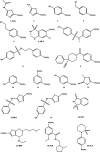In Silico-Guided Identification of New Potent Inhibitors of Carbonic Anhydrases Expressed in Vibrio cholerae
- PMID: 33214843
- PMCID: PMC7667831
- DOI: 10.1021/acsmedchemlett.0c00417
In Silico-Guided Identification of New Potent Inhibitors of Carbonic Anhydrases Expressed in Vibrio cholerae
Abstract
Carbonic anhydrases from Vibrio cholerae (VchCAs) play a significant role in bacterial pathophysiological processes. Therefore, their inhibition leads to a reduction of gene expression virulence and bacterial growth impairment. Herein, we report the first ligand-based pharmacophore model as a computational tool to study selective inhibitors of the β-class of VchCA. By a virtual screening on a collection of sulfonamides, we retrieved 9 compounds that were synthesized and evaluated for their inhibitory effects against VchCAβ as well as α- and γ-classes of VchCAs and selectivity over human ubiquitous isoforms hCA I and II. Notably, all tested compounds were active inhibitors of VchCAs. The N-(4-sulfamoylbenzyl)-[1,1'-biphenyl]-4-carboxamide (20e) stood out as the most exciting inhibitor toward the β-class (K i = 95.6 nM), also showing a low affinity against the tested human isoforms. By applying docking procedures, we described the binding mode of the inhibitor 20e within the catalytic cavity of the modeled open conformation of VchCAβ.
Conflict of interest statement
The authors declare no competing financial interest.
Figures







Similar articles
-
4-Sulfamoylphenylalkylamides as Inhibitors of Carbonic Anhydrases Expressed in Vibrio cholerae.ChemMedChem. 2021 Dec 14;16(24):3787-3794. doi: 10.1002/cmdc.202100510. Epub 2021 Oct 18. ChemMedChem. 2021. PMID: 34592052 Free PMC article.
-
Benzoxaboroles: New Potent Inhibitors of the Carbonic Anhydrases of the Pathogenic Bacterium Vibrio cholerae.ACS Med Chem Lett. 2020 Sep 9;11(11):2277-2284. doi: 10.1021/acsmedchemlett.0c00403. eCollection 2020 Nov 12. ACS Med Chem Lett. 2020. PMID: 33214840 Free PMC article.
-
Quinazoline-sulfonamides with potent inhibitory activity against the α-carbonic anhydrase from Vibrio cholerae.Bioorg Med Chem. 2014 Oct 1;22(19):5133-40. doi: 10.1016/j.bmc.2014.08.015. Epub 2014 Aug 21. Bioorg Med Chem. 2014. PMID: 25194929
-
Antibacterial carbonic anhydrase inhibitors targeting Vibrio cholerae enzymes.Expert Opin Ther Targets. 2024 Jul;28(7):623-635. doi: 10.1080/14728222.2024.2369622. Epub 2024 Jul 19. Expert Opin Ther Targets. 2024. PMID: 39028535 Review.
-
Inhibition of the archaeal beta-class (Cab) and gamma-class (Cam) carbonic anhydrases.Curr Top Med Chem. 2007;7(9):901-8. doi: 10.2174/156802607780636753. Curr Top Med Chem. 2007. PMID: 17504135 Review.
Cited by
-
Structure-Activity Relationship Studies of Acetazolamide-Based Carbonic Anhydrase Inhibitors with Activity against Neisseria gonorrhoeae.ACS Infect Dis. 2021 Jul 9;7(7):1969-1984. doi: 10.1021/acsinfecdis.1c00055. Epub 2021 Mar 25. ACS Infect Dis. 2021. PMID: 33765392 Free PMC article.
-
Repurposing FDA-approved sulphonamide carbonic anhydrase inhibitors for treatment of Neisseria gonorrhoeae.J Enzyme Inhib Med Chem. 2022 Dec;37(1):51-61. doi: 10.1080/14756366.2021.1991336. J Enzyme Inhib Med Chem. 2022. PMID: 34894972 Free PMC article.
-
Evaluation of the In Vitro Antifungal Activity of Novel Arylsulfonamides against Candida spp.Microorganisms. 2023 Jun 8;11(6):1522. doi: 10.3390/microorganisms11061522. Microorganisms. 2023. PMID: 37375025 Free PMC article.
-
Benzenesulfonamide derivatives as Vibrio cholerae carbonic anhydrases inhibitors: a computational-aided insight in the structural rigidity-activity relationships.J Enzyme Inhib Med Chem. 2023 Dec;38(1):2201402. doi: 10.1080/14756366.2023.2201402. J Enzyme Inhib Med Chem. 2023. PMID: 37073528 Free PMC article.
-
Bacterial carbonic anhydrases: underexploited antibacterial therapeutic targets.Future Med Chem. 2021 Oct;13(19):1619-1622. doi: 10.4155/fmc-2021-0207. Epub 2021 Aug 12. Future Med Chem. 2021. PMID: 34382415 Free PMC article. Review. No abstract available.
References
LinkOut - more resources
Full Text Sources
Chemical Information

